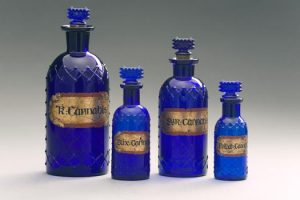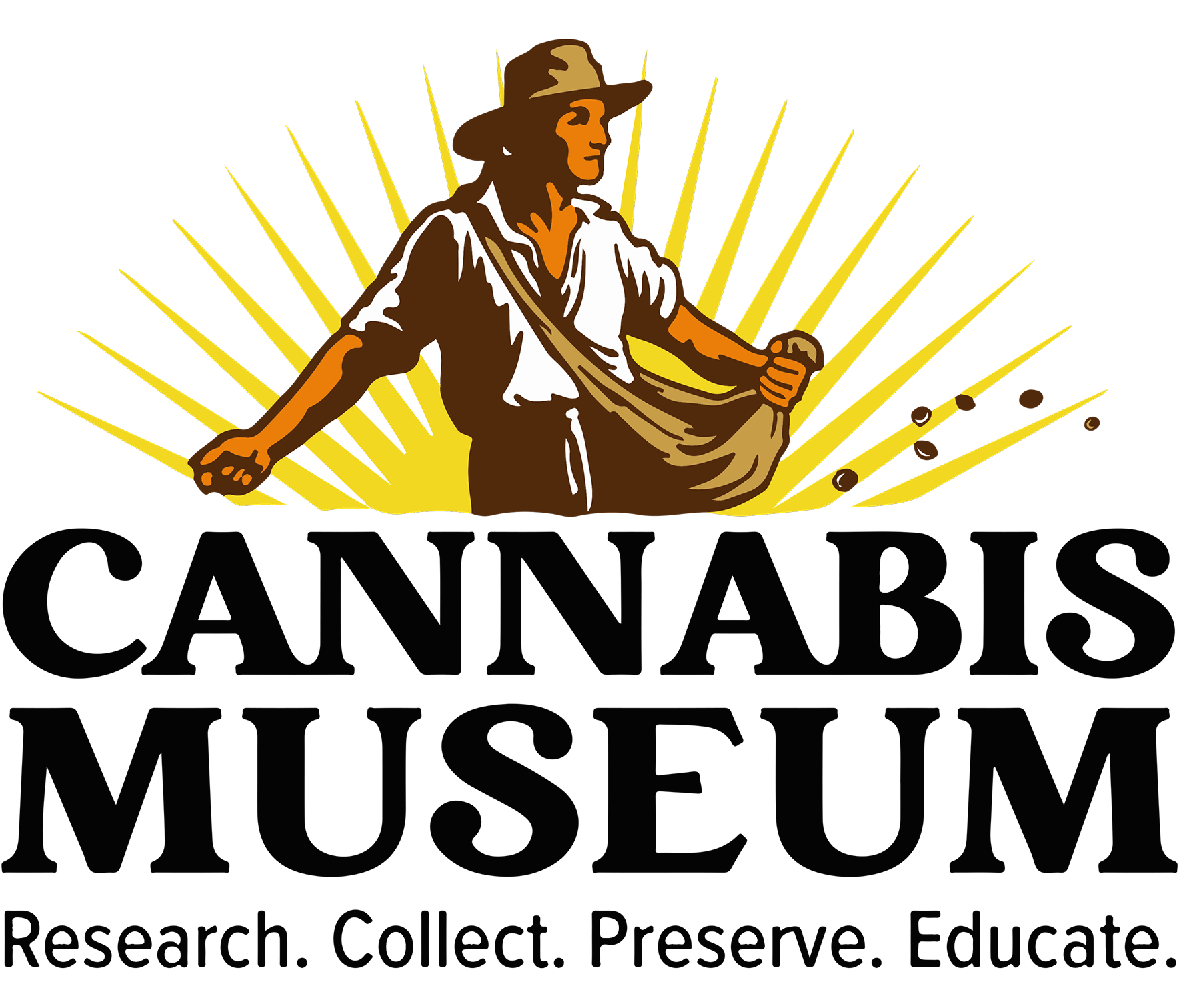Cannabis Concentrates in Blue Poison Bottles
 Cannabis in herbal form was known to be safe to use, but the concentrations that began to become available in the second half of the nineteenth century were respected for their power. These were almost always dispensed in containers marked as potentially poisonous. In 1872, the American Medical Association recommended the use of textured, colored glass containers for the storage and dispersion of potentially poisonous medicines. That same year, Whitall Tatum Glassworks of Millville, NJ introduced the textured surface cobalt blue poison bottle. Available in nine sizes, the surface has a pattern of diamond shaped projections around the bottle. The bottle was intended to “protect patients from danger of mistake both day and night, by the touch as well as sight.” Whitall Tatum never patented the design. The bottle was widely imitated by competitors and became the most widely used poison bottle in the country. The four bottles in this image feature the Whitall Tatum & Co. stopper with cork shells. In 1884, a patent for the design of these cobalt blue stoppers with the word “poison” boldly embossed and “studded on all five faces with pyramidal projections” was filed by Whitall Tatum. These poison stoppers stayed popular well into the twentieth century. The hand-lettered labels are all the same pattern and scaled according to the bottle size. The gold leaf labels are applied directly to the bottle surface and feature red stripes on the top and the bottom, as well as hand-illustrated acanthus leaves in the corners. TR: Cannabis, Tincture Cannabis. A tincture is an extract made by soaking herbs in a liquid, most often in alcohol, for a specific amount of time; then the plant material is strained and discarded. The bottom is embossed with “H.B. CO.,” the trademark of Hagerty Brothers. The 7″ tincture bottle was made in a two-piece mold that dates to the very early twentieth century. The “prescription lip” is designed with a flared mouth and a thin lip for the precise dripping of the bottles contents. Elix: Cannab., Elixir Cannabis. An elixir is an aromatic or sweetened hydro-alcoholic solution with at least one active ingredient, in this case, Cannabis. The alcohol present plays several roles: to extract the active ingredient, to improve the taste, to slow down the sugar crystallization, and to preserve the solution. The bottom of this 4 1/2″ tall two-piece molded bottle is embossed with “WTCO,” which is a Whitall Tatum Company bottle first introduced in 1872. This particular version dates back to the early 1900s. FL: Ext: Cannab., Fluid Extract Cannabis. Fluid extract is a liquid preparation of a medicinal plant made through percolation by using alcohol as a solvent and a preservative. The classic extract is formulated so that each 1 ml of fluid contains the therapeutic constituent of one gram of the beneficial drug that it represents. This 3 3/4″ bottle is embossed with “H.B. CO.,” a smaller version of the tincture bottle above. SYR: Cannabis, Syrup of Cannabis. Syrup, another preparation of the medical ingredient, is an aqueous solution of sugar. Glycerin was often added to increase solubility and slow crystallization. The 5 1/2″ syrup bottle has a thin neck intended to hold a somewhat loose fitting glass stopper to accommodate the buildup of sticky syrups. The base has a faint, unrecognizable, bottom emboss.
Cannabis in herbal form was known to be safe to use, but the concentrations that began to become available in the second half of the nineteenth century were respected for their power. These were almost always dispensed in containers marked as potentially poisonous. In 1872, the American Medical Association recommended the use of textured, colored glass containers for the storage and dispersion of potentially poisonous medicines. That same year, Whitall Tatum Glassworks of Millville, NJ introduced the textured surface cobalt blue poison bottle. Available in nine sizes, the surface has a pattern of diamond shaped projections around the bottle. The bottle was intended to “protect patients from danger of mistake both day and night, by the touch as well as sight.” Whitall Tatum never patented the design. The bottle was widely imitated by competitors and became the most widely used poison bottle in the country. The four bottles in this image feature the Whitall Tatum & Co. stopper with cork shells. In 1884, a patent for the design of these cobalt blue stoppers with the word “poison” boldly embossed and “studded on all five faces with pyramidal projections” was filed by Whitall Tatum. These poison stoppers stayed popular well into the twentieth century. The hand-lettered labels are all the same pattern and scaled according to the bottle size. The gold leaf labels are applied directly to the bottle surface and feature red stripes on the top and the bottom, as well as hand-illustrated acanthus leaves in the corners. TR: Cannabis, Tincture Cannabis. A tincture is an extract made by soaking herbs in a liquid, most often in alcohol, for a specific amount of time; then the plant material is strained and discarded. The bottom is embossed with “H.B. CO.,” the trademark of Hagerty Brothers. The 7″ tincture bottle was made in a two-piece mold that dates to the very early twentieth century. The “prescription lip” is designed with a flared mouth and a thin lip for the precise dripping of the bottles contents. Elix: Cannab., Elixir Cannabis. An elixir is an aromatic or sweetened hydro-alcoholic solution with at least one active ingredient, in this case, Cannabis. The alcohol present plays several roles: to extract the active ingredient, to improve the taste, to slow down the sugar crystallization, and to preserve the solution. The bottom of this 4 1/2″ tall two-piece molded bottle is embossed with “WTCO,” which is a Whitall Tatum Company bottle first introduced in 1872. This particular version dates back to the early 1900s. FL: Ext: Cannab., Fluid Extract Cannabis. Fluid extract is a liquid preparation of a medicinal plant made through percolation by using alcohol as a solvent and a preservative. The classic extract is formulated so that each 1 ml of fluid contains the therapeutic constituent of one gram of the beneficial drug that it represents. This 3 3/4″ bottle is embossed with “H.B. CO.,” a smaller version of the tincture bottle above. SYR: Cannabis, Syrup of Cannabis. Syrup, another preparation of the medical ingredient, is an aqueous solution of sugar. Glycerin was often added to increase solubility and slow crystallization. The 5 1/2″ syrup bottle has a thin neck intended to hold a somewhat loose fitting glass stopper to accommodate the buildup of sticky syrups. The base has a faint, unrecognizable, bottom emboss.
Purchase Print of Cannabis Concentrates in Blue Poison Bottles
12 x 18 Chroma print
20 x 30 Chroma print
12 x 18 Fine Art Print Only
Framed Print – 12 x 18 image in a 16 x 22 maple finish frame
Framed Print – 12 x 18 image in a 16 x 22 dark brown finish frame
12 x 18 Art Block – Natural
8 x 12 Art Block – Natural
Left to Right:
Turkish Hashish bottle, 7″ tall with a 2 1/4″ diameter, brown glass bottle marked W.T. & CO. A salt mouth pattern made by Whitall Tatum Company in Millville, NJ from 1868 until 1903, it has a mushroom pattern snug fitting top. The glass label is hand lettered with red top and bottom bands, an early safety warning.
Moroccan Hashish, 8 1/2″ tall with a 4 1/4″ diameter. This is a heavy and highly polished bottle with horizontal bands at the base and shoulder. The thin, wide lid with elegant top was cast in a three-piece mold.
Octagonal Hashish Humidor with a molded top that features a recess under the handle to place a small moistened sponge to humidify the contents. Both crude and pressed hashish, as well as other smoking herbs including tobaccos and Cannabis flower tops, were stored in accessible counter jars like these.
The rose tinted jar was cast in a three section mold. Hashish Jar, 3 1/4″ tall made in a two-piece mold. This bottle is from a home pharmacy chest.
The elegant beaded edged stopper was cast in a three-piece mold. Hashish, display bottle with white recessed label made by Whitall, Tatum & Company (W.T. & CO.) of Millville, NJ from 1868 to 1903.
The 12″ tall flint glass bottle was blown in a two-piece mold and has several casting blemishes on the shoulder and neck. Hashish, display bottle, 10″ tall show apothecary with matching swirled inverted acorn stopper, the shoulder and base are banded with a matching pattern.
The elegant rose cast is the result of selenium added to the glass. Hashish, 7 1/4″ tall bottle with a 2 3/4″ diameter purple glass, the result of added magnesium. The bottle has a tall applied neck that was left unfinished. The copper leaf label is hand lettered and outlined in asphaltum. The inner lip of the cast stopper is embossed “EDDY & EDDY MFG. CO.,” marking an early twentieth century St. Louis glass manufacturer.
Hashish, large, 12″ x 4 1/8″ square counter bottle blown in a three section mold. The hollow and indented stopper comes from a two-piece mold. The bottom is embossed “F&S, St. Louis Mo. Pat’d March 6th 1894.” Fay and Schueler Co., St. Louis, MO.
Hasheesh, brown bottle made in the late nineteenth century by Whitall Tatum Company (W.T. & CO.) of Millville, NJ. Blown in a two-piece mold with side seams, the 8″ tall by 2 3/4″ square has a salt neck.
Hasheesh, thin flint glass bottle, 5 1/2″ tall, blown in a one-piece wooden mold. The solid stopper made in a two-piece mold has an unfinished pontil scar. This label is an excellent example of a surface applied glass label patented in England on June 19, 1854 by W.J. Bisseker.
